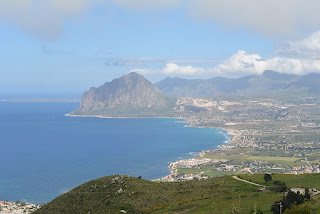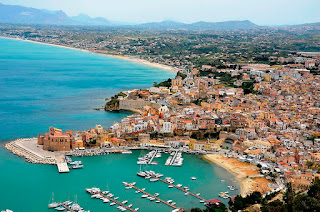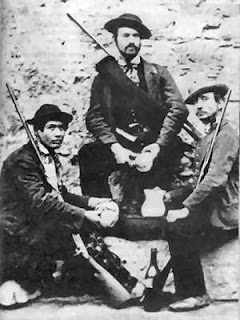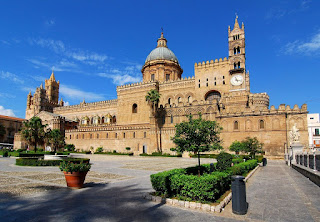Cop-turned-novelist with inside knowledge of police investigations
 |
| Michele Giuttari's novels draw on his experience as a high-ranking Italian police officer |
After studying for a degree in Jurisprudence at the University of Messina, Giuttari qualified as a lawyer. He joined the Polizia di Stato as a commissario in 1978 and later rose through the ranks to take charge of the Florentine police between 1995 and 2003.
Giuttari first served in Calabria, where he held positions in the Squadra Mobile of Reggio Calabria and Cosenza. He then joined the Anti-Mafia investigation department and served first in Naples and then in Florence, where he became head of the Judicial Investigation section, and succeeded in jailing several key Mafia figures.
During his time in command of the Squadra Mobile in Florence, Giuttari was responsible for reopening the Monster of Florence case and proving that the so-called monster was not simply a lone serial killer but was, in fact, a group of killers.
After retiring from serving in the Polizia di Stato, Giuttari started crime writing and has now written a series of novels featuring his character, Commissario Michele Ferrara, the latest, entitled Sangue sul Chianti (Blood on Chianti), having been published in 2021.
Seven novels in the Ferrara series have been published in English, the first of which - entitled A Florentine Death - will fascinate readers who are interested in learning about the methods or seeing into the minds of the Italian police. The book had been published in Italy under the title Scarabeo.
 |
| Michele Giuttari has made many appearances on television in Italy to talk about his life and work |
As well as providing an authentic account of police procedure in a multiple murder investigation, Giuttari delivers a cleverly plotted mystery that becomes increasingly more gripping as it reaches its dramatic conclusion.
A Death in Tuscany, the second Commissario Ferrara novel published in English, is also fascinating because it offers even more glimpses behind the scenes of an Italian police station and gives the readers the feeling that they are on the inside of a major police investigation.
In this novel, the reader finds out more about the man behind the job title and about his earlier life in Sicily.
Ferrara finds he is up against the Mafia as well as ruthless drugs bosses, and even his own Commissioner, who is enraged both by his unorthodox behaviour during the investigation and because he has fallen foul of the Carabinieri, pressures Giuttari himself has obviously experienced at times during his career.
 |
| The Death of a Mafia Don is available in English |
This is a fast moving novel about terrorism and Mafia activity in Italy seen from the perspective of the security forces. It shows the way the police and the Carabinieri often work together and there is a realistic portrait of Florence as the backdrop for the action.
Former policeman Giuttari has now achieved international success with his crime novels, which have been published in more than 100 countries, and he has won several literary awards, including the Fenice Europa for La Loggia degli Innocenti and the Camaiore Letteratura Gialla for Il Basilisco.
In a film made about the Monster of Florence murders, the character of Giuttari was played by the actor Giorgio Colangeli.
 |
| A typical street in historic Novara di Sicilia |
Situated about 70km (43 miles) southwest of Messina in the northeastern corner of Sicily, Michele Guittari’s beautiful home village of Novara di Sicilia is rich in history and traditions. Built on a hillside at the point where the Nebrodi mountains meet the Peloritani range, it was founded and inhabited by Greeks, then by Romans and Arabs and later conquered by the Normans. The remains of a Norman castle can be found near the Chiesa di San Giorgio. In the village’s historic centre, the Duomo di Santa Maria Assunta, built in the 16th century, has a sandstone façade typical of the area, with a wide staircase leading to an essentially Renaissance interior. Just 5km (3.5 miles) from the centre of the village is the Abbazia di Santa Maria, which dates back to the 12th century and is said to be the best example of a Cistercian building in Sicily.
Search accommodation in Novara di Sicilia with Hotels.com
 |
| The Cattedrale di Santa Maria Assunta - Cosenza's duomo - lies at the heart of the mediaeval city |
Calabria is a part of Italy which did not traditionally attract large numbers of overseas tourists but is becoming more popular thanks to beautiful coastal towns and villages such as Tropea, San Nicola Arcella and Pizzo, while the inland city of Cosenza - where Michele Giuttari once worked - has been described as epitomising the “unkempt charm of southern Italy” with a history that can be traced back to the third century, when there was a settlement called Consentia, the capital of the Brutti tribe. Over subsequent years, the area was captured by the Visigoths, the Lombards, the Saracens, the Normans and the Spanish before the Risorgimento and unification saw it become part of the new Italy. At the heart of the mediaeval old city, with its network of steep, narrow streets, is a cathedral originally built in the 11th century and modified many times subsequently. The old town also boasts the 13th century Castello Svevo, built on the site of a Saracen fortification, which hosted the wedding of Louis III of Naples and Margaret of Savoy, but which the Bourbons used as a prison.
Hotels in Cosenza from Expedia
Also on this day:
1576: The birth of Cardinal and art collector Scipione Borghese
1878: The birth of conductor Tullio Serafin
1886: The birth of vaudeville star Guido Deiro
1922: The birth of actor Vittorio Gassman



.jpg)





.jpg)



.jpg)






.jpg)
.png)

.jpg)






